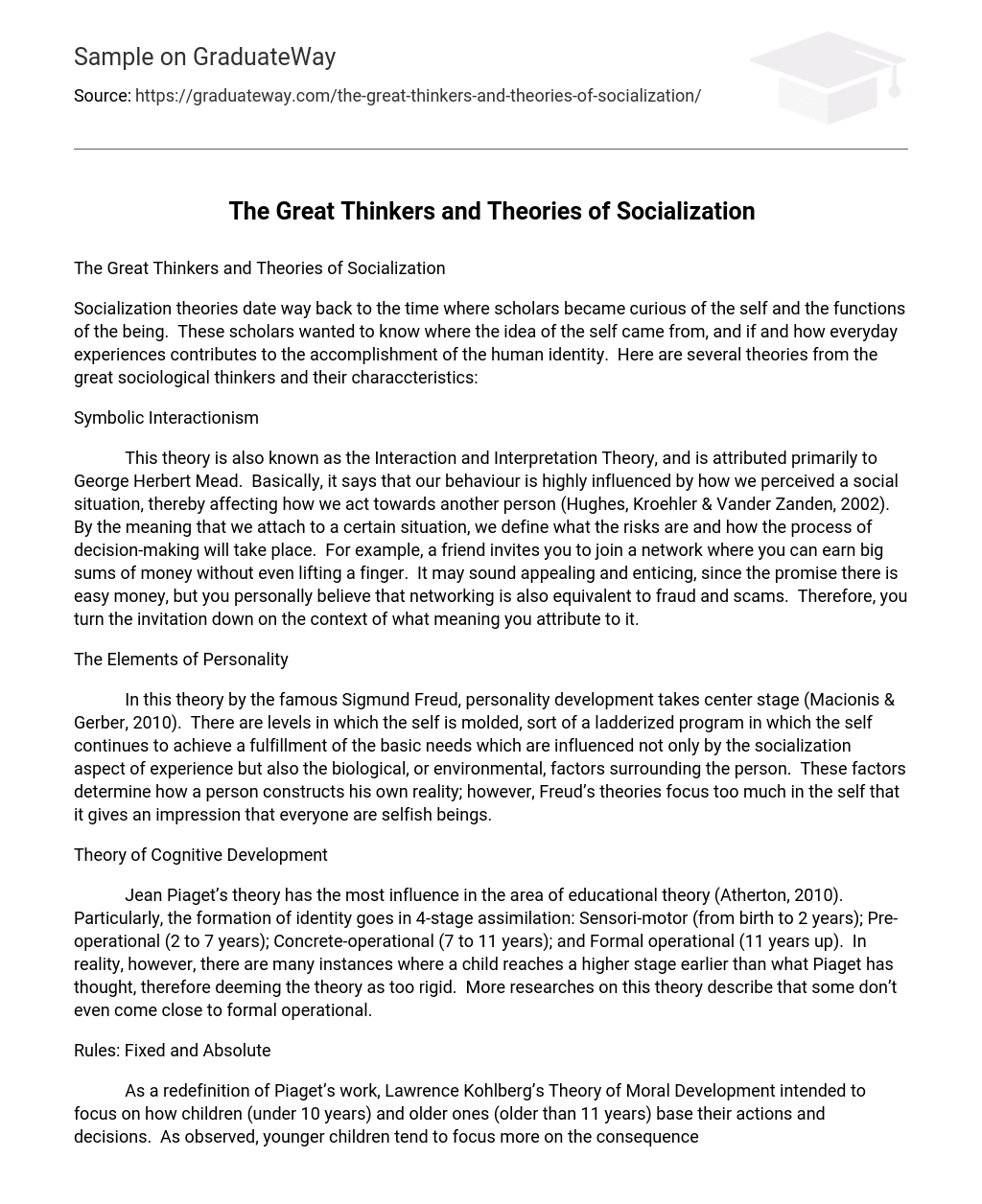Socialization theories date way back to the time where scholars became curious of the self and the functions of the being. These scholars wanted to know where the idea of the self came from, and if and how everyday experiences contributes to the accomplishment of the human identity. Here are several theories from the great sociological thinkers and their characcteristics:
Symbolic Interactionism
This theory is also known as the Interaction and Interpretation Theory, and is attributed primarily to George Herbert Mead. Basically, it says that our behaviour is highly influenced by how we perceived a social situation, thereby affecting how we act towards another person (Hughes, Kroehler & Vander Zanden, 2002). By the meaning that we attach to a certain situation, we define what the risks are and how the process of decision-making will take place. For example, a friend invites you to join a network where you can earn big sums of money without even lifting a finger. It may sound appealing and enticing, since the promise there is easy money, but you personally believe that networking is also equivalent to fraud and scams. Therefore, you turn the invitation down on the context of what meaning you attribute to it.
The Elements of Personality
In this theory by the famous Sigmund Freud, personality development takes center stage (Macionis & Gerber, 2010). There are levels in which the self is molded, sort of a ladderized program in which the self continues to achieve a fulfillment of the basic needs which are influenced not only by the socialization aspect of experience but also the biological, or environmental, factors surrounding the person. These factors determine how a person constructs his own reality; however, Freud’s theories focus too much in the self that it gives an impression that everyone are selfish beings.
Theory of Cognitive Development
Jean Piaget’s theory has the most influence in the area of educational theory (Atherton, 2010). Particularly, the formation of identity goes in 4-stage assimilation: Sensori-motor (from birth to 2 years); Pre-operational (2 to 7 years); Concrete-operational (7 to 11 years); and Formal operational (11 years up). In reality, however, there are many instances where a child reaches a higher stage earlier than what Piaget has thought, therefore deeming the theory as too rigid. More researches on this theory describe that some don’t even come close to formal operational.
Rules: Fixed and Absolute
As a redefinition of Piaget’s work, Lawrence Kohlberg’s Theory of Moral Development intended to focus on how children (under 10 years) and older ones (older than 11 years) base their actions and decisions. As observed, younger children tend to focus more on the consequences of their actions, while those older focus on the intention. These are two very different perspectives influencing intellectual development. This theory is less rigid than Piaget’s, and produced 6 stages, only three of which is similar to the former’s (Crain, 1985)
Boys vs. Girls
Only Carol Gilligan has taken into account the gender of children when it comes to socialization. The focus primarily of the theory is the differences in how girls and boys approach morality with interpersonal communication and as an effect of the connection of the child to its mother. Boys use the justice perspective, where they assume that something is not right if it doesn’t follow set rules; Girls, on the other hand, use the care and responsibility theory, where a judgment is morally wrong if it damages relationships.
References:
Atherton, J.S. (2010). Learning and Teaching: Piaget’s Developmental Theory. Retrieved on July 19, 2010 from http://www.learningandteaching.info/learning/piaget.htm
Crain, W.C. (1985). Theories of Development: Kohlberg’s Stages of Moral Development. Prentice-Hall, 118-136. Retrieved on July 19, 2010 from http://faculty.plts.edu/gpence/html/kohlberg.htm
Hughes, M., Kroehler, C.J., Vander Zanden, J.W. (2002). Sociology: The Core. McGraw-Hill Higher Education. Retrieved on July 19, 2010 from http://highered.mcgraw-hill.com/sites/007240535x/student_view0/chapter3/chapter_summary.html
Macionis, J.J., & Gerber, L.M. (2010). Sociology: Sixth Canadian Edition. Pearson Education. Retrieved on July 19, 2010 from http://wps.pearsoned.ca/ca_ph_macionis_sociology_6/73/18922/4844242.cw/index.html





